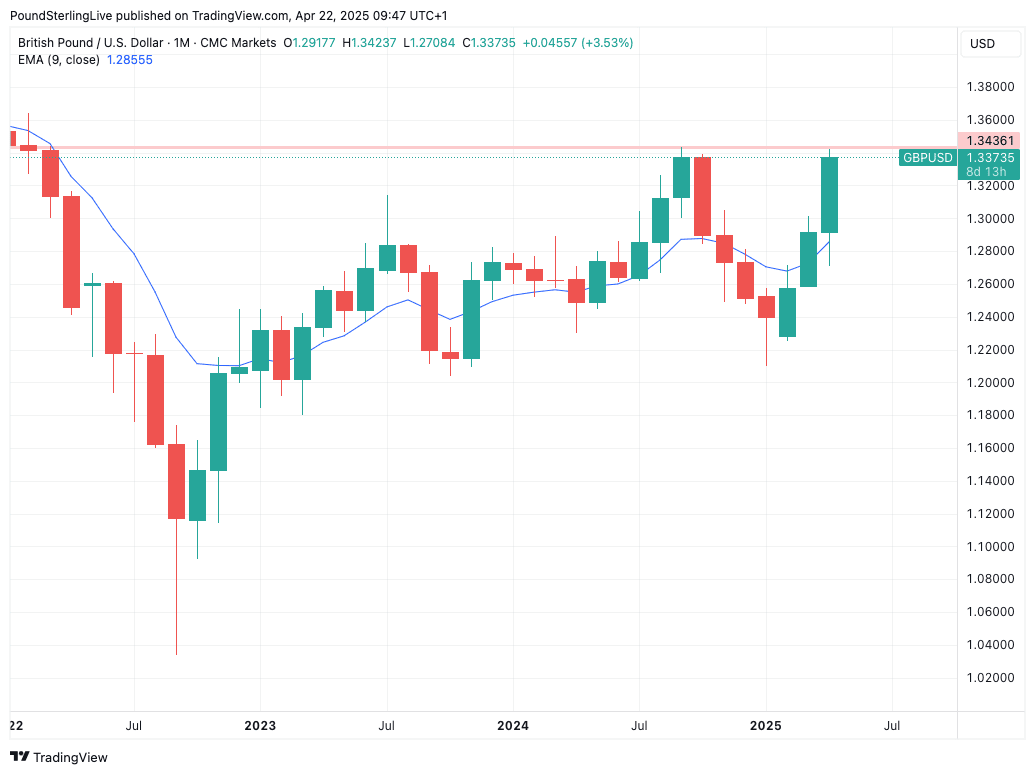
Image © The White House
British Pound Gains against the Dollar, but losses against the Euro mount.
The British pound struck its highest level in seven months against the Dollar amidst renewed fears for the independence of the U.S. Federal Reserve after President Donald Trump launched a fresh attack on Chair Jerome Powell.
Stocks and the Dollar fell after investors feared Trump's latest comments would erode the Fed's independence and, in doing so, undermine faith in U.S. financial markets.
"'Preemptive Cuts' in interest rates are being called for by many. With energy costs way down, food prices (including Biden’s egg disaster!) substantially lower, and most other 'things' trending down, there is virtually no inflation," said Trump on Truth Social.
"With these costs trending so nicely downward, just what I predicted they would do, there can almost be no inflation, but there can be a SLOWING of the economy unless Mr. Too Late, a major loser, lowers interest rates, NOW. Europe has already 'lowered' seven times. Powell has always been 'To Late,' except when it came to the Election period when he lowered in order to help Sleepy Joe Biden, later Kamala, get elected. How did that work out?" he added.
Stock markets fell following the communication: the S&P 500 closed down 2.38% at 5,158.20, while the technology-heavy Nasdaq fell 2.5% to 15,870.90, while the Dow Jones industrial average slid 2.48% to 38,170.41.
"The US dollar index declined to its weakest level since 2022 after President Donald Trump’s criticism of Federal Reserve Chair Jerome Powell contributed to fears over the independence of the central bank," says Mark Haefele, Global Wealth Management Chief Investment Officer at UBS AG.
The Pound-to-Dollar exchange rate rose to 1.2423, a level last seen in September 2024. A succession of 12 daily gains also marks the longest winning streak since 1971, when Sterling switched to the decimal system.
Above: GBPUSD at monthly intervals. The graphical resistance could halt gains, as per our Week Ahead Forecast.
GBP/EUR Struggles
Falling equity markets confirm a 'risk off' sentiment exists in global markets, which traditionally prompts GBP weakness against the JPY, CHF, USD and EUR.
With the cause of the market's worries emanating from the U.S., the USD is not a participant in 'safe haven' flows. However, the EUR is pressuring the Pound-to-Euro exchange rate.
GBP/EUR is trading at 1.1620, having fallen 2.65% already this month.
"When sentiment is positive, sterling appreciates; in negative global conditions, it becomes vulnerable," says George Vessey, Lead FX Strategist at Convera.
The Fed Will Behave Differently, Regardless
Investors fear the central bank's independence from political influence risks being undermined, which dents faith in the U.S. economy and financial markets.
Last Thursday Trump said the "termination" of Jerome Powell as Federal Reserve chairman "cannot come fast enough".
The attacks on the Fed add another prong to 2025's 'sell-America' trade, which quickly replaced the "U.S. exceptionalism" trade of 2024, which coincided with fresh multi-year highs in the Dollar.
"The consensus was pricing U.S. exceptionalism through non-inflationary tax cuts financed by government efficiency and deregulation, which would have been USD positive. So far, we see a policy mix closer to a stagflationary scenario, with government spending cuts and high tariffs, which has been USD negative," says Athanasios Vamvakidis, FX Strategist at Bank of America.
Trump cannot remove Powell, but concerns reach markets via two channels:
1) The Fed's Committee members are not immune to pressure and might shift behaviour (i.e. cut when previously they would have preferred to hold).
2) Powell's term ends in May 2026, and it is clear Trump would appoint a 'dove' who has his ear.
This suggests forward-looking markets are also factoring in a far 'looser' monetary policy dictated by the Oval Office from 2026.
Lower rates would, in theory, lower borrowing costs, pressure bond yields and lead to USD weakness.
"We believe Trump will likely name a successor later this year, even assuming he won't fire Powell. And on trade, we expect the news flow to improve. Trump said Thursday that “big progress” was being made in trade negotiations with Japan, helping lift market sentiment late in the week. Nonetheless, investors should prepare for a volatile path ahead," says Haefele.
Trump Irked by Powell's Comments
"Our obligation is to keep longer-term inflation expectations well-anchored and to make certain that a one-time increase in the price level does not become an ongoing inflation problem," Jerome Powell said in Chicago last week.
Following the comments, Trump told reporters in the White House:
"If I want him out, he'll be out of there real fast, believe me... I'm not happy with him."
In 2024, the Fed completed an interest rate raising cycle that took the benchmark lending rate to a multi-decade high of between 5.25% and 5.5%.
The Fed has since started lowering interest rates, which are now 4.25% to 4.5%, a whole point lower than where they were a year ago.
However, a resurgence in inflation means the Fed has had to halt the cutting process, which means borrowing costs have stopped falling.
Should inflation continue to rise, rates will be held for longer, leading to a slowdown in the economy.
The Fed’s next board meeting is on 6 and 7 May and Trump is likely to pressure the Fed ahead of it, but it is unlikely that officials will budge.

